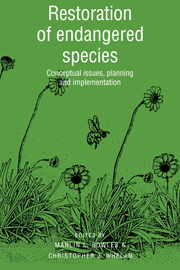Book contents
- Frontmatter
- Contents
- List of contributors
- Foreword
- Acknowledgments
- I Conceptual issues in restoration ecology
- 1 Organizational and managerial guidelines for endangered species restoration programs and recovery teams
- 2 Genetic considerations for plant population restoration and conservation
- 3 Managing genetic diversity in captive populations of animals
- 4 The relationship of rarity to plant reproductive biology
- 5 Experimental evidence for insect impact on populations of short-lived, perennial plants, and its application in restoration ecology
- II Restoration planning
- III Implemented restorations
- IV Synthesis and future directions: biology, politics and reality
- Taxonomic Index
- Subject Index
3 - Managing genetic diversity in captive populations of animals
Published online by Cambridge University Press: 27 January 2010
- Frontmatter
- Contents
- List of contributors
- Foreword
- Acknowledgments
- I Conceptual issues in restoration ecology
- 1 Organizational and managerial guidelines for endangered species restoration programs and recovery teams
- 2 Genetic considerations for plant population restoration and conservation
- 3 Managing genetic diversity in captive populations of animals
- 4 The relationship of rarity to plant reproductive biology
- 5 Experimental evidence for insect impact on populations of short-lived, perennial plants, and its application in restoration ecology
- II Restoration planning
- III Implemented restorations
- IV Synthesis and future directions: biology, politics and reality
- Taxonomic Index
- Subject Index
Summary
Introduction
The best opportunity for endangered species recovery exists when there are still populations throughout the original range, even if the populations are small and widely separated. As long as organisms persist in natural, though perhaps highly degraded or modified, habitats, recovery can be achieved by habitat improvement, reduction in causes of mortality, and other management actions that allow existing populations to expand. The second best opportunity for endangered species recovery exists when the species has been eliminated over portions of its range, but still survives in healthy populations in other portions of its range. In such cases, organisms can be translocated to vacant habitats, after the original causes of decline and local extinction have been ameliorated.
Often, however, action for endangered species recovery is delayed beyond the point when in situ management or even translocation among natural areas is possible. Remnant wild populations, if they exist at all, may not be self-sustaining, and it may be impossible to reverse their decline before the projected date of extinction. For example, black-footed ferrets (Mustela nigripes) were thought to be extinct until a single population of about 30–50 adults was discovered near Meeteetse, Wyoming, in 1981 (see Clark 1989, and Chapter 11). That population crashed in 1985 and 1986, when a plague epidemic decimated the prairie dog colony that was the primary food base for the ferrets, and then an epidemic of distemper decimated the ferrets themselves.
- Type
- Chapter
- Information
- Restoration of Endangered SpeciesConceptual Issues, Planning and Implementation, pp. 63 - 89Publisher: Cambridge University PressPrint publication year: 1994
- 58
- Cited by



